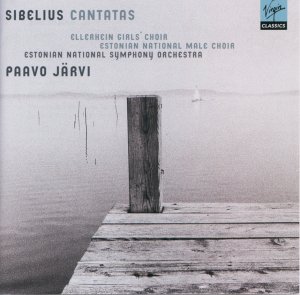Sibelius wrote too little for most of us. Of
such captivating and compelling quality are the major, repeatedly
recorded, works that listeners will always be curious about the
rest. Who knows … in due time some Sibelian academic of the 2030s
may yet give us a speculative relaisation of the Eighth Symphony.
Unthinkable? Impossible? I wonder.
Looking through the Sibelius catalogue is rather
like browsing the Nielsen lists. Among the tone poems, concertos
(one in the case of Sibelius) and symphonies are dotted various
cantatas and celebratory choral works. These occasional pieces
were for many years disregarded. Now come opportunities to assess
them for the first time. Very welcome too.
Nielsen's choral-orchestral pieces largely await
exploration by the record companies. Sibelius has been more fortunate.
Thor Johnson and the Cincinnati orchestra recorded The Origin
of Fire in the days of LP (Varèse-Sarabande VC81941,
reissued as late as circa 1977). Two cantatas, The Origin of
Fire and Oma Maa were added as makeweights to Berglund's
second recording (1980s) of Kullervo with the Helsinki
Philharmonic. The Bis Sibelius Edition (which has recently reached
its 51st volume) has included such works but they are scattered
here and there across a variety of discs and couplings.
Snöfrid pleasingly sets a
Swedish text by Viktor Rydberg for female orator and mixed choir.
Its saga subject has temptress trolls, a storm (evoked in the
first few minutes) and a defiant hero. The women's voices have
a most agreeable recorded presence. Just before they enter we
have a startlingly familiar gesture from the Second Symphony.
The pleasing immediacy of the choir also registers in the lovely
roundedness of the Oma Maa which is concerned with
evocations of Midnight Sun not nationalistic bombast. The music
becomes increasingly devotional with its invocation and praise
centring on nature and the sun. If you think in terms of the glowing
choral version of Rakastava with an added vibrancy then
you are not far amiss in understanding this work. Väinön
virsi is a late work piece but you must not expect anything
revolutionary. Here Sibelius keys back into the idiom he had in
the 1890s. This is related to the Karelia music. The subject
is from the Kalevala where Väinämöinen prays to
Jumala, the Creatrix, for protection, strength and harvests. This
is more dramatically drawn than Oma Maa and in the background
the clink of Väinämöinen's forge can be heard as
the singing rises to the glowing sun-dazzled heights. Maan
Virsi is for mixed chorus (not as described in the booklet
and insert). The zither-like kantele is evoked by the pizzicato
writing. A relaxed serenade at 3.51 for orchestra delightful ushers
in the returning choir. This is classically poised Sibelius rising
to the best structured climactic statement on the disc (5.48).
Sandels was composed in Berlin.
It is named after a General Sandels (1764-1831). The music starts
out as jaunty storytelling with jolly clarinet solo work (tr.
4, 2.49) but from 4.38 Sibelius brings his sharply-focused imagination
to bear on the battle scene with many memorable orchestral touches.
It ends with brass ‘barks’ reminiscent of Finlandia. Just
occasionally in this work his choral writing can veer into school
song jollity but usually the treatment swerves back into fresher
material before too much damage is done. Both Snöfrid
and Sandels are termed 'improvisations'. Laulu Lemminkäiselle
is robustly cheerful and strongly rhythmic - well within
the stirring Scandinavian male choral tradition and related in
style to the Karelia's alla marcia. Finally comes
the choral (men's voices) version of Finlandia.
This is stirringly done though I have heard more threateningly
imposing and rapped out brass playing - for example on the Stein
(Decca) and Barbirolli (EMI Classics) readings of the orchestral
version.
The disc is very well documented with full texts
in Finnish and with side by side translations into German, French
and English.
Sibelians will welcome this collection as might
choral conductors looking for ideas for a short concert appetiser
(none of these pieces are longer than 12 minutes). Sibelians will
want to hear the battle scene in Sandels, the rounded invocation
of Oma Maa and the superbly structured Maan Virsi.
Rob Barnett
